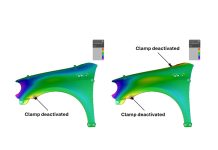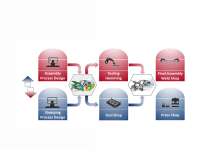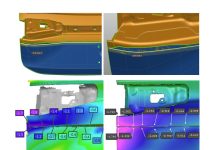Towards Applying Thin-Gauge AHSS to Outer Panels

Lightweight construction is becoming ever more important in the automotive industry. Demanding C.A.F.E standards have set in motion a common drive to reduce weight in automobiles in an effort to lower fuel consumption and to limit CO2 emissions.
Consider China for example; their government recently set ambitious targets to become the world leaders in new energy vehicle (NEV) technology, with a particular focus on light-weighting. Other governments will soon follow suit, bringing many challenges for OEMs.
In order to meet growing demand for this trend the Auto/Steel Partnership set up the ‘Hemming of Thin Gauge High-Strength Steel’ (HSS) project to determine the best means of reducing weight for the largest panels.
High strength and advanced high strength steels (HSS / AHSS) typically are used extensively for body-in-white structural components; exterior Class-A panels have been limited to mild dent-resistant steels and aluminum alloys. The purpose of this project therefore was to demonstrate that thin-gauge HSS are an acceptable option for automotive production, which would not only reduce the weight of these outer panels but still meet vehicle safety standards.
These panels include: body sides and roofs, hoods and doors, and lastly deck lids.
The steel-making partners provided three grades of HSS, namely: BH 280 gauge 0.55 mm, BH 440 gauge 0.55 mm and DP 490 gauge 0.50 mm. The questions were – are these higher yield strength materials formable and capable of being hemmed; and is simulation technology up to the challenge of predicting detailed outcomes of sophisticated hemming processes using such materials? Naturally in the realm of forming Class A panels the issue of style also must remain integral seeing that it is these outer panels that determine a car’s visual appeal for customers and therefore, ultimately, have an impact on sales.
So what happened in the project?
Inner and outer panels were stamped, and roll-hemmed assemblies were produced by Superior CAM in Michigan. Stamping and hemming simulations were conducted using AutoForm Software, including the AutoFormplusR6-HemPlanner. Roll hemming is common in the production of closure assemblies, and is generally more complex (due to process control) than table-top/de-hemming which achieves hemming in one go; and even better – roll hemming is more cost effective for small batches (although slower than table-top/die hemming) due to having significantly lower tool cost. The roll-hemming process – simulated as in reality as well – was realized in 3 passes: 50°, 30° and the final pass.

And the results are in! Simulations were accurately predictive of eventual stamping and hemming outcomes on physical panels and assemblies:
- Wrinkling occurred in all expected places.
- As typical, thinning became more pronounced after hemming.
- Springback was correctly simulated.
- Crucial hemming quality metrics were also predicted well: roll-in, creepage, and hem thickness.
Interestingly, during simulation the selected high-strength materials displayed the same type of traits in forming and assembly as typically seen in handling widely-used materials. The simulation did reveal some differences, and yet these details may be used beneficially to assist in deciding which parameters to use for any given part.
Total all three materials could produce a part which may be manufactured in reality.

Not only was it demonstrated that such high strength materials can indeed be formed and that hemming may be applied effectively, it was done without having to add more complexity to the forming process. Our goal of proving that simulation software can capture accurate simulation results for high strength panels was therefore realized.
Although starting with a small part, thin gauge high-strength steel does indeed offer another alternative for producing real size lightweight panels, opening many doors to the future.













